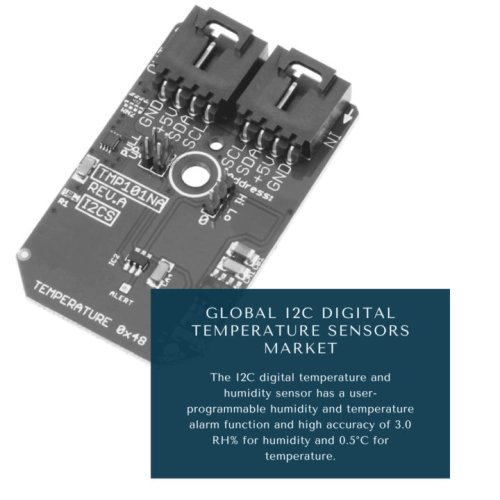
- Get in Touch with Us

Last Updated: Apr 25, 2025 | Study Period: 2024-2030
The I2C digital temperature and humidity sensor has a user-programmable humidity and temperature alarm function and high accuracy of 3.0 RH% for humidity and 0.5°C for temperature.

The housing is made of 304 stainless steel to withstand high temperatures, low temperatures, chemicals, and impacts well.
For ease of wiring, the sensor output is designed with a DuPont 2.54 connector. Additionally, the sensor can be utilized directly with microcontrollers like Arduino thanks to the presence of two built-in 4.7K pull-up resistors and one 100nF filtering capacitor.
Electronic, medical, automotive, industrial, weather, home appliances like HVAC, dehumidifiers, and refrigerators, testing and inspection equipment, and other relevant temperature and humidity measurements and controls can all benefit from this temperature and humidity sensor.
Applications - HVAC Dehumidifiers and refrigerators Testing and inspection equipment Other relevant temperature and humidity measurements and controls User-programmable temperature and humidity alarm response address (ARA) Features - 304 stainless steel, good impact resistance, low power consumption, and high accuracy.
The Global I2C Digital Temperature Sensors market accounted for $XX Billion in 2023 and is anticipated to reach $XX Billion by 2030, registering a CAGR of XX% from 2024 to 2030.
To meet any requirement for thermal management, NXP Semiconductors' I2C-bus temperature monitors offer industry-leading precision.
These I2C temperature sensors combine everything the customer needs to quickly and easily determine the heat generated by other board components and control fans and other cooling mechanisms to improve system performance.Applications for these temperature sensors include:RDIMMs, industrial controllers, electronic equipment, and personal computers.
Temperature Accuracy: 0.5°C Accurate temperature sensor Internal 12-bit A-to-D converter (resolution: 0.0625°C) Programmable under and over temperature alerts Performance: Operating voltage: 1.4V to 3.6V Low quiescent current:6A, the maximum
The P3T1085UK is a temperature-to-digital converter with a range of -40 °C to +125 °C and an accuracy of 0.5 °C.With over temperature detection, it makes use of an on-chip band gap temperature sensor and an A-to-D conversion method.
A temperature resolution of 0.0625 °C is provided by the twelve-bit two-component data that is always stored in the temperature register.
The P3T1085UK can be set up to operate under a variety of conditions:one-shot mode, shutdown mode, and continues conversion.As a communication interface, the device supports I2C (up to 3.4 MHz) and 2-wire serial I3C (up to 12.5 MHz).
The device has an alert function and supports up to four target addresses in I2C.The devices support IBI (In-Band Interrupt) in I3C, in which the alert interrupts are reported on the same bus.
| Sl no | Topic |
| 1 | Market Segmentation |
| 2 | Scope of the report |
| 3 | Abbreviations |
| 4 | Research Methodology |
| 5 | Executive Summary |
| 6 | Introduction |
| 7 | Insights from Industry stakeholders |
| 8 | Cost breakdown of Product by sub-components and average profit margin |
| 9 | Disruptive innovation in the Industry |
| 10 | Technology trends in the Industry |
| 11 | Consumer trends in the industry |
| 12 | Recent Production Milestones |
| 13 | Component Manufacturing in US, EU and China |
| 14 | COVID-19 impact on overall market |
| 15 | COVID-19 impact on Production of components |
| 16 | COVID-19 impact on Point of sale |
| 17 | Market Segmentation, Dynamics and Forecast by Geography, 2024-2030 |
| 18 | Market Segmentation, Dynamics and Forecast by Product Type, 2024-2030 |
| 19 | Market Segmentation, Dynamics and Forecast by Application, 2024-2030 |
| 20 | Market Segmentation, Dynamics and Forecast by End use, 2024-2030 |
| 21 | Product installation rate by OEM, 2023 |
| 22 | Incline/Decline in Average B-2-B selling price in past 5 years |
| 23 | Competition from substitute products |
| 24 | Gross margin and average profitability of suppliers |
| 25 | New product development in past 12 months |
| 26 | M&A in past 12 months |
| 27 | Growth strategy of leading players |
| 28 | Market share of vendors, 2023 |
| 29 | Company Profiles |
| 30 | Unmet needs and opportunity for new suppliers |
| 31 | Conclusion |
| 32 | Appendix |